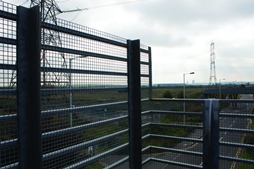An In-depth Analysis of Galvanised Stainless Steel Grade 304 & 316 Wire Mesh: Applications, Advantages and Differences
04-01-2024
Stainless steel wire mesh, particularly grades 304 and 316, holds a dominant position in various industrial applications due to their remarkable attributes such as strength, durability, and resistance to corrosion. This comprehensive guide will explore the common uses, benefits and distinctions between these two grades of stainless steel wire mesh.
Understanding Stainless Steel Wire Mesh
Wire mesh, often referred to as wire cloth or wire fabric, is a versatile material made of intersecting metallic wires. These wires are woven, welded, or strung together in a grid-like pattern, creating a sheet with uniformly spaced openings. Among the various metals used to manufacture wire mesh, stainless steel, specifically grades 304 and 316, is the most popular due to its exceptional characteristics.
What is Stainless Steel?
Stainless steel is a generic term used in metallurgy to describe a steel alloy with a chromium content of 10.5% or more. The inclusion of chromium in stainless steel grants it a higher resistance to corrosion compared to plain or carbon steel. This resistance is due to the unique property of chromium to combine with oxygen in the atmosphere, forming a thin protective layer of chromium oxide on the steel’s surface.
Stainless Steel Grade 304 Wire Mesh
Type 304 stainless steel, an alloy containing 18% chromium and 8% nickel, is one of the most widely available stainless steels in the wire mesh industry. Its versatility and affordability make it a popular choice for a plethora of applications.
Key Features of 304 Stainless Steel
Heat Resistance: It can withstand high temperatures, up to 1600 °F in intermittent service and 1700 °F in continuous service.
Non-magnetic: In its annealed condition, 304 stainless steel is virtually non-magnetic.
Corrosion Resistance: It offers resistance to corrosion and is unlikely to oxidise.
Workability: It can be easily formed and cut to size with appropriate tools and machinery.
Applications of 304 Stainless Steel Wire Mesh
304 Stainless Steel wire mesh has a broad range of applications across various sectors:
Filtration Applications: Includes liquid filtration, particle sieving, petroleum refining, and chemical processing.
Production of Security Screens, Baskets, and Decorations.
Industries Served: Aerospace, architecture, chemical, food production and processing, mining, petroleum, and pharmaceuticals.
Stainless Steel Grade 316 Wire Mesh
Grade 316 stainless steel is a premium alloy containing 16% chromium, 10% nickel, along with 2% of the chemical element molybdenum. Although slightly pricier than 304, it offers numerous benefits.
Key Features of 316 Stainless Steel
Corrosion Resistance: It offers more resistance to corrosion than 304, making it suitable for marine environments.
Heat Resistance: Resilient in extreme temperatures.
Non-magnetic: Like 304, it is also non-magnetic.
Welding Properties: Resistant to spot welding.
Applications of 316 Stainless Steel Wire Mesh
316 Stainless Steel wire mesh is commonly used across various sectors:
Marine Technology: Boat fittings, marine components.
Chemical Processing and Storage: Cisterns and piping, containment of pressurised gasses or liquids.
Heavy Welding and Infrastructure: Heavy machinery, construction materials.
Laboratory Use: Particle separation, testing equipment.
Comparing 304 and 316 Stainless Steel Wire Mesh
While both grades 304 and 316 are widely used, their suitability depends on the specific requirements of the application. Grade 316 is typically recommended for marine environments and heavy welding where 304 isn’t as stable. However, 304 is more affordable, making it a go-to choice for various applications.
Benefits of Using Stainless Steel Wire Mesh
The stainless steel alloys’ unique mix of favourable characteristics makes them a preferred choice for wire mesh production.
Durability: They are strong, durable metals that can resist mechanical and chemical damage.
Chemical Resistance: They resist corrosion and oxidation, making them a good choice for filters and other products that will come into contact with water and chemicals.
Workability: They are very formable, easy to fabricate and shape, and simple to clean without causing damage.
Strength and Mechanical Resistance: Known for their impact resistance and ability to perform well in low-temperature environments.
Conclusion
In conclusion, stainless steel wire mesh, particularly grades 304 and 316, are versatile materials that cater to a wide range of applications. While both are durable and corrosion-resistant, 316’s added properties make it suitable for harsher environments. Understanding the specific requirements of each application is crucial in deciding which grade to utilise.
Contact us today to learn more about our range of high-quality stainless steel and wire products. We offer a wide range of finishing processes and treatments, wire forming, sheet metal fabrication, machining, and welding services as a one-stop-shop for custom metal and wire goods.





